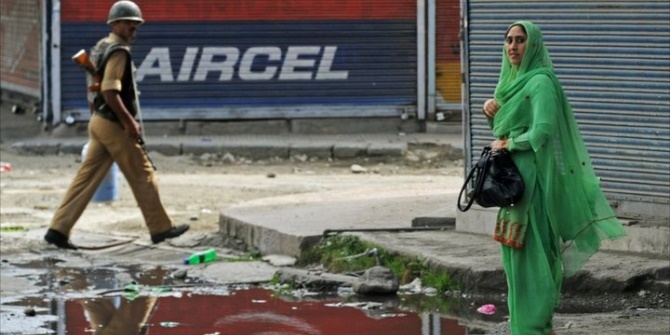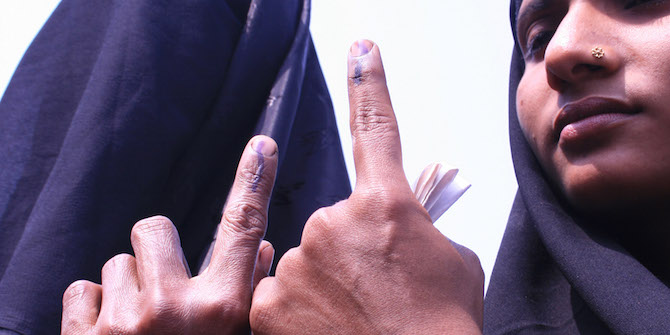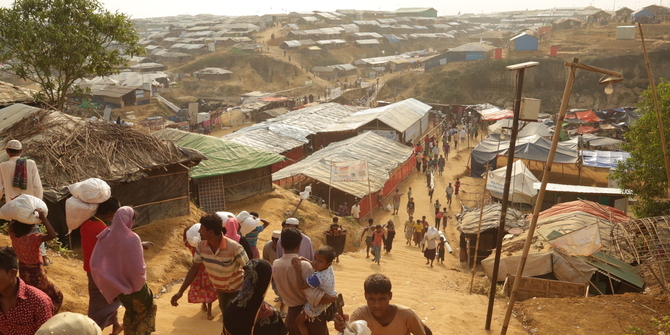 The killing of a senior militant commander in Kashmir a month ago sparked a series of protests across the Valley. A heavy-handed response from security forces has left scores of civilians dead, thousands injured, including hundreds at risk of blindness owing to the widespread use of pellet guns. Mark Mistry, who visited the disputed territory in May, examines the reasons behind the reactions of the people as the new Chief Minister’s reputation lies in tatters.
The killing of a senior militant commander in Kashmir a month ago sparked a series of protests across the Valley. A heavy-handed response from security forces has left scores of civilians dead, thousands injured, including hundreds at risk of blindness owing to the widespread use of pellet guns. Mark Mistry, who visited the disputed territory in May, examines the reasons behind the reactions of the people as the new Chief Minister’s reputation lies in tatters.
“The Kashmiri will not accept defeat in a hurry.” – AS Dulat, former chief of India’s external intelligence agency, the Research & Analysis Wing
The façade of ‘normalcy’
Hizbul Mujahideen’s Burhan Wani was an instantly recognisable face to millions of Kashmiris, resulting from his adept use of social media while alive. In death too his name will live on as the spark that fuelled the Valley’s latest bout of blood-letting. More than 50 lie dead, and thousands (members of the security forces included) have been injured in confrontations between protestors, police and the alphabet soup of Indian paramilitary and armed forces that inhabit the Vale of Kashmir in their hundreds of thousands.
Before Burhan’s death, the portents weren’t good. I visited during the Durbar move in May, which marks the shift of the seat of state government from Jammu to Srinagar, the summer capital. Preparations included the dredging of Dal Lake, where weeds excavated from the waterbody were subsequently dumped on The Boulevard, the road that rings the lake’s perimeter. It was, at that time, was packed with tourists. Central reservations were painted without being first primed, and grass turf was laid in Pratap Park, in the centre of Lal Chowk, only hours before the arrival of the new Chief Minister, Mehbooba Mufti. Each of these Sisyphean tasks contributed to the façade of ‘normalcy’.
By this time Mehbooba, the daughter of previous Chief Minister Mufti Sayeed, had been in power for barely a month. Her prevarication over the state government’s formation won her few friends. Re-entering her father’s alliance with the BJP, India’s ruling party, saw her form a Faustian pact that would undo the previous goodwill towards her garnered from her trips to see relatives of slain militants. That she was unable to obtain any concessions from New Delhi served only to highlight the weakness of her position in the eyes of many Kashmiris.
Early missteps by Mehbooba’s administration included the mishandling of the sensitive subject of Sainik colonies – housing settlements for ex-Army personnel. Understandably the very suggestion of housing for veterans drew ridicule from many across the Valley, given the already overwhelming presence of security forces. The policy was first denied by a state government spokesman. The authorities then changed tack and blamed the National Conference, which ran Jammu & Kashmir under Omar Abdullah’s tenure as Chief Minister. Secondly, the state government tried to force through a new industrial policy that would have allowed non-locals to acquire large tracts of land for developing private industries. The state government backtracked after the separatist leadership formed a united front on the issue.
Ultimately, by denying separatist leaders political space, New Delhi stored up trouble for itself, catalysed by the communal tint of its plans to relocate Kashmiri Pandits into separate settlements. This series of events illustrate a government led by events rather than in control.
Conflict and communications
Photographs from Wani’s funeral procession provide an insight into the resilience of anti-Indian sentiments and the pro-freedom movement. Long before his death people had been displaying their reverence for slain militants by participating in funeral processions in their thousands. During “encounters” earlier this year (a somewhat euphemistic description given to armed confrontation between security forces and militants) police and army found their pursuit of militants hampered, as people would flock to sites of reported confrontations to provide militants with a means of escape. These snippets signal that sentiment among Kashmiris was already strengthening before the latest major conflagration.

These forms of resistance have been further bolstered by authorities’ cack-handed attempt at censorship. Newspapers were banned for days, internet and mobile telephone services were cut, along with text messaging services. Nor did it stop there – the BBC ran a report documenting the suspension of Facebook accounts belonging to journalists, academics and others who has used their ‘walls’ to draw attention to the activities of security forces in Kashmir.
India is one of the fastest growing economies in the world, and its huge population represents a golden opportunity for digitally-driven revenues. Facebook knows this to its cost having been denied a licence to establish its Free Basics service in Indian earlier this year. Therefore it is somewhat inevitable that the social media giant’s suspending of accounts would lead to controversy. For its part, Facebook has been clear that its actions against accounts relaying the situation in Kashmir were aimed at preventing the spread of terrorism. In a statement provided to the BBC, the Silicon Valley-based company said: “Facebook’s community standards prohibit support or praise for organisations and the leaders of those organisations that engage in terrorist activity from using the platform.”
While there is no evidence to support that view that Facebook might be seeking favour from the Indian Government, it has the motive to do so. Facebook has form here. Earlier this year it removed a post by Mir Suhail Qadiri, a talented political cartoonist, marking the hanging of Afzal Guru on February 9, 2013 in Tihar Jail, New Delhi. Guru was imprisoned for his alleged part in the 2001 Indian Parliament attacks. Newspaper circulation was curbed then too in the days following his death. Describing the cartoon, which shows the roots of a Chinar tree stretching from Kashmir to the jail in Delhi, Suhail said: “His grave is in Tihar so I showed how his roots in Kashmir connect.”
Discredited dance
As has sadly become routine, whichever mainstream (non-separatist) party not in power will make raise questions of human rights abuses and point fingers at the state government. This time round it is Omar Abdullah’s National Conference (NC) that finds itself saying soothing words to the Valley’s inhabitants while they mourn their dead. On August 3, the former chief minister tweeted: “Two more protestors killed last night. The CM still wants to behave as though it’s business as usual but why is the centre oblivious?”
But Kashmiris have long memories, and recall that it was under Abdullah’s watch that more than one hundred protestors were killed following a ‘fake encounter’ where Indian Armed Forces had sought to paint civilians as militants in a district of Kupwara.
Both Mufti’s PDP and National Conference have participated in this discredited dance with New Delhi. Kashmiris know that it matters not who is in the Chief Minister’s chair, as the actions of the state remain the same.
Mirwaiz Umar Farooq told me in May that,
They [state government] are locking down every possibility where people want to engage peacefully and academically and socially. The answer is definitely going to be again on the streets.
I believe in the long run this is death of the PDP. Mainstream parties like NC/PDP in terms of governance maybe there are the ones in the fray but they are losing the people. They are letting down their own people and their own state and for petty politics and petty perks, they are doing damage to the identity of the Kashmir issue.
The Mirwaiz’s prescient statement brings us to the crux of the problem, which is self-determination for Kashmir. But the question itself is far from straightforward – how would this be done without leading to ‘Balkanisation’, as respected South Asia specialist Myra McDonald asked in an exchange on social media with a Kashmiri journalist. Yet until Kashmiris themselves are consulted on what their future should look like the unrest is likely to continue, as Kashmir-commentator Christopher Snedden posits in a well-reasoned blogpost.
Three things can be said with certainty. Firstly, the inescapable conclusion of so many eye injuries caused by pellet guns is that the security forces using them are shooting to kill by aiming at people’s heads. Secondly, those doing the killing will not, at least in the short term, to be brought to justice, as the (Jammu & Kashmir 1990) Armed Forces Special Powers Act grants immunity to security forces. Finally, the present situation makes a mockery of the world’s largest democracy.
This article gives the views of the author, and not the position of the South Asia @ LSE blog, nor of the London School of Economics. Please read our comments policy before posting.
About the author
 Mark Mistry is a freelance journalist who has reported from Indian-administered Kashmir, and elsewhere across South Asia, for the Wall Street Journal, The Independent and the Frontline Club. He has contributed three previous articles on Kashmir to the South Asia @ LSE blog. He lives in London and tweets @mark_mistry.
Mark Mistry is a freelance journalist who has reported from Indian-administered Kashmir, and elsewhere across South Asia, for the Wall Street Journal, The Independent and the Frontline Club. He has contributed three previous articles on Kashmir to the South Asia @ LSE blog. He lives in London and tweets @mark_mistry.








Oppression, Suppression and force occupation never lasts for a long.
Writer ignored UN resolution.
Western world has keen interest in Bharti market.
Wani was not a militant leader but a freedom fighter.
Policymakers should understand, such brutal practices never sustain for a long. Winning heart is more important than oppression.
Muhammad Naeem ul Fateh